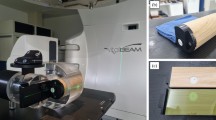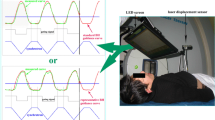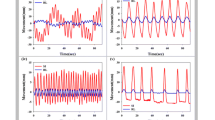Abstract
TomoTherapy can provide highly accurate SABR deliveries, but currently it does not have any effective motion management techniques. Shallow breathing has been identified as one possible motion management solution on TomoTherapy, which has been made possible with the BreatheWell audiovisual biofeedback (AVB) device. Since both the shallow breathing technique and the clinical use of the BreatheWell device are novel, their implementation requires comprehensive verification and validation work. As the first stage of the validation, this paper investigates the impact of target motion on a TomoTherapy SABR delivery is assessed on both 3D CT and 4D CT using a 4D respiratory phantom. A dosimetric study on a 4D respiratory phantom was conducted, with the phantom’s insert designed to move at four different amplitudes in the superior-inferior direction. SABR plans on 3D and 4D CT scans were created and measured. Critical plan statistics and measurement results were compared. It is found that for TomoTherapy SABR deliveries, by reducing the targets respiratory motion, target coverage, organ-at-risk (OAR) sparing, and delivery accuracy were improved.












Similar content being viewed by others
References
Boggs H, Feigenberg S, Walter R, Patel DWB, Wu T, Rosen L (2012) Stereotactic body radiation therapy using tomotherapy for early stage NSCLC: the utility of mid-fraction CT scans to assess intrafraction tumour motion. Int J Radiat Oncol Biol Phys 84(3S):S559–S560
Gallo JJ, Kaufman I, Powell R et al (2015) Single-fraction spine SBRT end-to-end testing on TomoTherapy, Vero, TrueBeam, and CyberKnife treatment platforms using a novel anthropomorphic phantom. J Appl Clin Med Phys 16(1):170–182
Hodge W, Tomé WA, Jaradat HA et al (2006) Feasibility report of image guided stereotactic body radiotherapy (IG-SBRT) with tomotherapy for early stage medically inoperable lung cancer using extreme hypofractionation. Acta Oncol 45(7):890–896
Nagai A, Shibamoto Y, Yoshida M, Inoda K, Kikuchi Y (2014) Safety and efficacy of intensity-modulated stereotactic body radiotherapy using helical tomotherapy for lung cancer and lung metastasis, Bio Med Res Int. https://doi.org/10.1155/2014/473173
Lee D, Greer PB, Ludbrook J et al (2016) Audiovisual biofeedback improves cine-magnetic resonance imaging measured lung tumour motion consistency. Int J Radiat Oncol Biol Phys 94(3):628–636
Ekberg L, Holmberg O, Wittgren L, Bjelkengren G, Landberg T (1998) What margins should be added to the clinical target volume in radiotherapy treatment planning for lung cancer? Radiother Oncol 48:71–77
Barnes EA, Murray BR, Robinson DM, Underwood LJ, Hanson J, Roa WH (2001) Dosimetric evaluation of lung tumour immobilization using breath hold at deep inspiration. Int J Radiat Oncol Biol Phys 50(4):1091–1098
Kim T, Pollock S, Lee D, O’Brien R, Keall P (2012) Audiovisual biofeedback improves diaphragm motion reproducibility in MRI. Med Phys 39(11):6921–6928
Davies SC, Hill AL, Holmes RB, Halliwell M, Jackson PC (1994) Ultrasound quantitation of respiratory organ motion in the upper abdomen. Br J Radiol 67(803):1096–1102
Suramo I, Paivansalo M, Myllyla V (1984) Cranio-caudal movements of the liver, pancreas and kidneys in respiration. Acta Radiol Diagn 25(2):129–131
Korin HW, Ehman RL, Riederer SJ, Felmlee JP, Grimm RC (1992) Respiratory kinematics of the upper abdominal organs: a quantitative study. Magn Reson Med 23(1):172–178
Wade O (1954) Movement of the thoracic cage and diaphragm in respiration. J Physio 124:193–212
O’Connell BF, Irvine FM, Cole AJ, Hanna GG, McGarry CK (2015) Optimizing geometric accuracy of four-dimensional CT scans quired using the wall- and couch-mounted Varian® Real-time Position Management™ camera systems. Br J Radiol 88(1046):20140624. https://doi.org/10.1259/bjr.20140624
Wong JW, Sharpe MB, Jaffray DA et al (1999) The use of active breathing control (ABC) to reduce margin for breathing motion. Int J Radiat Oncol Bio Phys 44(4):911–919
Remouchamps VM, Letts N, Vicini FA et al (2003) Initial clinical experience with moderate deep-inspiration breath hold using an active breathing control device in the treatment of patients with left-sided breast cancer using external beam radiation therapy. Int J Radiat Oncol Bio Phys 56(3):704–715
Bert C, Metheany KG, Doppke K, Chen GT (2005) A phantom evaluation of a stereo-vision surface imaging system for radiotherapy patient setup. Med Phys 32(9):2753–2762
Giraud P, Houle A (2010) Respiratory gating for radiotherapy: main technical aspects and clinical benefits. Bull Cancer 97(7):847–856. https://doi.org/10.1684/bdc.2010.1143
Keall PJ, Mageras GS, Balter JM et al (2006) The management of respiratory motion in radiation oncology report of AAPM Task Group 76. Med Phys 33(10):3874–3900
Byrne M, Hu Y, Archibald-Heeren B (2016) Evaluation of RayStation robust optimisation for superficial target coverage with setup variation in breast IMRT. Australas Phys Eng Sci Med 39:705–716
C-RAD Pty Ltd. CatalystTM Tomo–Improved Positioning Workflow for TomoTherapy [BROCHURE]. https://c-rad.se/content/uploads/2015/06/A4_C-RAD_folder_TomoTherapy_pages.pdf. Accessed 14th Dec 2018
Opus Medical Pty Ltd. Breathe well patient information. https://breathewell.co/patient-information/. Accessed 3 Nov 2017
Pollock S. Translational research of audiovisual biofeedback: an investigation of respiratory-guidance in lung and liver cancer patient radiation therapy (Doctoral dissertation). Retrieved from Sydney Digital Theses Database. http://hdl.handle.net/2123/15902. Accessed 8 Nov 2017
Venkat RB, Sawant A, Suh Y, George R, Keall PJ (2008) Development and preliminary evaluation of a prototype audiovisual biofeedback device incorporating a patient-specific guiding waveform. Phys Med Biol 53(11):N197–N208
Modus Medical Devices Inc. State-of-the-art breathing simulator using patient respiratory waveforms. https://modusqa.com/motion/phantom. Accessed 8 Nov 2017
Sangalli G, Passoni P, Cattaneo GM et al (2011) Planning design of locally advanced pancreatic carcinoma using 4DCT and IMRT/IGRT technologies. Acta Oncol 50:72–80
Kim YJ, Jang SJ, Han JB et al (2014) Motion and volume change of tumor tissue depending on patient position in liver cancer treatment with use of tomotherapy. Ann Nucl Energy 65:174–180
Nakamura M, Narita Y, Matsuo Y et al (2008) Geometrical differences in target volumes between slow CT and 4D CT imaging in stereotactic body radiotherapy for lung tumours in the upper and middle lobe. Med Phys 35(9):4142–4148
Purdie TG, Moseley DJ, Bissonnette J et al (2006) Respiration correlated cone-beam computed tomography and 4DCT for evaluating target motion in Stereotactic Lung Radiation Therapy. Acta Oncol 45(7):915–922
Archibald-Herren B, Byrne M, Hu Y, Cai M, Wang Y (2017) Robust optimization of VMAT for lung cancer: dosimetric implications of motion compensation techniques. J Appl Clin Med Phys 18(5):104–116
Wiant D, Vanderstraeten C, Maurer J, Pursley J, Terrell J, Sintay BJ (2014) On the validity of density overrides for VMAT lung SBRT planning. Med Phys 41(8):081707. https://doi.org/10.1118/1.4887778
Badkul R, Pokhrel D, Ramanjappa T, Jiang H, Lominska C, Wang F (2016) Measurement of dose blurring effect due to respiratory motion for lung stereotactic body radiation therapy (SBRT) using Monte Carlo based calculation algorithm. Med Phys 43(6):3592
Yu CX, Jaffray DA, Wong JW (1998) The effects of intra-fraction organ motion on the delivery of dynamic intensity modulation. Phys Med Biol 43:91–104
Bortfeld T, Jokivarsi K, Goitein M, Kung JH, Jiang SB (2002) Effects of intra-fraction motion on IMRT dose delivery: statistical analysis and simulation. Phys Med Biol 47(13):2203–2220
Jiang SB, Pope C, Al Jarrah KM, Kung JH, Bortfeld T, Chen GT (2003) An experimental investigation on intra-fractional organ motion effects in lung IMRT treatments. Phys Med Biol 48(12):1773–1784
Kissick M, Boswell S, Jeraj R, Mackie TR (2005) Confirmation, refinement, and extension of a study in intrafraction motion interplay with sliding jaw motion. Med Phys 32(7):2346–2350
Kanagaki B, Read PW, Molloy JA, Larner JM, Sheng K (2007) A motion phantom study on helical tomotherapy: the dosimetric impacts of delivery technique and motion. Phys Med Biol 52:243–255
Zhu Z, Fu X (2015) The radiation techniques of tomotherapy and intensity-modulated radiation therapy applied to lung cancer. Transl Lung Cancer Res 4(3):265–274
Author information
Authors and Affiliations
Corresponding author
Ethics declarations
Ethical approval
The authors declare that no ethical approval is required.
Additional information
Publisher’s Note
Springer Nature remains neutral with regard to jurisdictional claims in published maps and institutional affiliations.
Rights and permissions
About this article
Cite this article
Hu, Y., Archibald-Heeren, B., Byrne, M. et al. Investigating the impact of tumour motion on TomoTherapy stereotactic ablative body radiotherapy (SABR) deliveries on 3-dimensional and 4-dimensional computed tomography. Australas Phys Eng Sci Med 42, 169–179 (2019). https://doi.org/10.1007/s13246-019-00727-8
Received:
Accepted:
Published:
Issue Date:
DOI: https://doi.org/10.1007/s13246-019-00727-8




